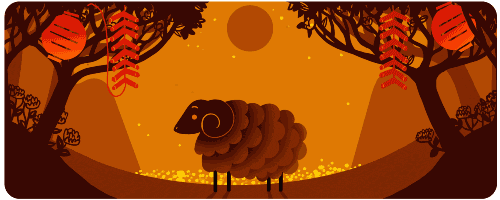This year in the Chinese Lunisolar tradition the Lunar New Year, The Year Of The Goat, begins on Thursday, February 19th. Kung Hei Fat Choy! The traditional blessing spoken on that day essentially means, “Congratulations and may you prosper in the coming year!”
The New Year is celebrated with Lion Dancers and fireworks, family gatherings and meals, the giving of gifts in red envelopes and putting up decorative banners of chunlián, a poetic couplet that expresses hopeful thoughts for the new year. On one side of the door a banner may read, Winter has gone, on the mountain clear water sparkles, on the other, Spring comes, a bird sings amid fragrant flowers. Often while the phrases work in harmony, the characters from which they are formed create antithesis.
In a parallel to the Western Zodiac tradition, the Chinese tradition follows a 12 year cycle, with each year having an animal symbol. The animals of the Chinese tradition are Rat, Ox, Tiger, Rabbit, Dragon, Snake, Horse, Goat, Monkey, Rooster, Dog, and Pig.
Unlike the Western Zodiac, these animals are not associated with constellations; traditionally the Chinese sky is divided into 5 great palaces, with 28 mansions, ruled over by the Emperor of Heaven and his Celestial Court. Events in Heaven parallel those on Earth, and these regions have their own symbolic creatures and their own complex mythology. First mentioned in the ancient book of divination, the Book Of Changes or I Ching, the four directions of the compass and the four seasons are ruled over by their own mystical animals, the Blue Dragon for east and spring, the Red Phoenix for south and summer, the White Tiger for west and autumn, and the Black Tortoise for north and winter.
Like the Western Zodiac, the animals of the Chinese cycle of years imbue particular traits on those born under their auspices. A person born in the year of the Goat, 1931, 1943, 1955, 1967, 1979, 1991, 2003 and 2015 will be gentle, serene, creative, amicable, persevering, they have a tendency, like their totem spirit, to be at home in groups, but never seek the centre of attention. They are at home in their thoughts. While they enjoy spending on fashions and the finer things, they do so out of pleasure, not elitism or snobbery.
You may have noticed the Google Doodle, the variations on the art for the Google logo that appears on the Google homepage which celebrates various cultural and holiday events, for The Chinese Year Of The Goat features an animation of a fluffy, curly horned, creature, butting its head on a tree, with lanterns sparking fireworks. Have Google goofed, have they bungled their doodle, with this picture of a Ram instead of Goat? Some linguists have pointed out that the Chinese Zodiac character that means Goat, yáng ( 羊 ) also means Ram, and also means Sheep. So which is it?
Shanyáng, 山 羊 , which means goat, is comprised of two characters, shan ( 山 ), which means mountain, and yáng ( 羊 ), which means sheep. So a mountain sheep is a goat. However, as is common with many words, when shanyáng is shortened to yáng, to mean goat, out of context it can be read as sheep, but actually it still means goat.
In this case it seems inauspicious for Google, as the old Chinese proverb has it, 順手牽羊/顺手牵羊, while one must always take the opportunity to pilfer a goat, (Shùn shǒu qiān yáng), one should perhaps make sure that one has not got the ram by the horns.




